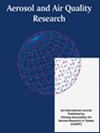普通呼吸器和面罩材料的过滤性能和纤维脱落行为
IF 2.5
4区 环境科学与生态学
Q3 ENVIRONMENTAL SCIENCES
引用次数: 1
摘要
佩戴呼吸器和口罩可以有效保护公众免受COVID-19感染。因此,有必要对常用的呼吸器和口罩的性能进行评估。开发了两个实验系统来研究七种不同的掩模材料,这些材料的纤维尺寸范围从0.1µm (100 nm)到20µm (20,000 nm)。其中一个系统是计算机控制的装置,用于测量过滤性能,包括与尺寸相关的过滤效率和压降,而另一个系统用于测试材料的纤维脱落行为。采用扫描电镜(SEM)技术对非织造布、驻极体处理介质、棉织物和纳米纤维介质制备的材料进行了尺寸和结构观察。研究表明,3M N95口罩整体过滤性能最好,过滤效率超过95%,压降低至74.1 Pa。两款商品棉口罩的过滤性能总体最差,过滤效率在25%左右。7种防护口罩材料未发现断裂纤维;然而,我们发现了SHEMA97面罩可能脱落的树突结构,其大小与其纳米级纤维相当。提出了造成这种现象的原因。本文章由计算机程序翻译,如有差异,请以英文原文为准。
Filtration Performance and Fiber Shedding Behavior in Common Respirator and Face Mask Materials
Wearing respirators and face masks is effective for protecting the public from COVID-19 infection. Thus, there is a need to evaluate the performance of the commonly used respirators and face masks. Two experimental systems were developed to investigate seven different mask materials, which have a fiber size range from 0.1 µ m (100 nm) to 20 µ m (20,000 nm). One of the systems is a computer-controlled setup for measuring the filtration performance, including size-dependent filtration efficiency and pressure drop, while the other system is for testing the fiber shedding behavior of the materials. The technique of scanning electron microscope (SEM) was applied to observe the dimensions and structures of those materials, which are made of nonwoven-fabrics electret-treated media, cotton woven fabrics, or nanofiber media. The study indicated that the 3M N95 respirator has the best overall filtration performance with over 95% efficiency and low pressure drop of 74.1 Pa. The two commercial cotton face masks have the worst filtration performance in general, with a filtration efficiency of around 25%. No broken fibers from by the seven tested respirator and face mask materials were discovered; however, dendrite structures likely shed by the SHEMA97 face mask with a size comparable to its nanoscale fibers were identified. The reason for this phenomena is presented.
求助全文
通过发布文献求助,成功后即可免费获取论文全文。
去求助
来源期刊

Aerosol and Air Quality Research
ENVIRONMENTAL SCIENCES-
CiteScore
8.30
自引率
10.00%
发文量
163
审稿时长
3 months
期刊介绍:
The international journal of Aerosol and Air Quality Research (AAQR) covers all aspects of aerosol science and technology, atmospheric science and air quality related issues. It encompasses a multi-disciplinary field, including:
- Aerosol, air quality, atmospheric chemistry and global change;
- Air toxics (hazardous air pollutants (HAPs), persistent organic pollutants (POPs)) - Sources, control, transport and fate, human exposure;
- Nanoparticle and nanotechnology;
- Sources, combustion, thermal decomposition, emission, properties, behavior, formation, transport, deposition, measurement and analysis;
- Effects on the environments;
- Air quality and human health;
- Bioaerosols;
- Indoor air quality;
- Energy and air pollution;
- Pollution control technologies;
- Invention and improvement of sampling instruments and technologies;
- Optical/radiative properties and remote sensing;
- Carbon dioxide emission, capture, storage and utilization; novel methods for the reduction of carbon dioxide emission;
- Other topics related to aerosol and air quality.
 求助内容:
求助内容: 应助结果提醒方式:
应助结果提醒方式:


